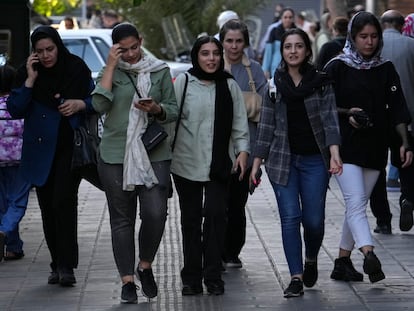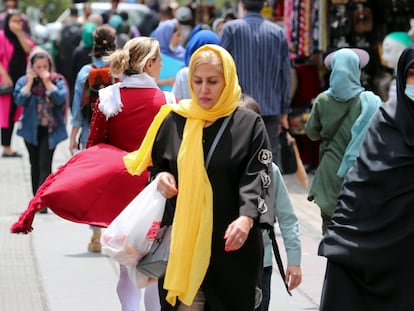Activists in Europe mark the anniversary of Mahsa Amini’s death in police custody in Iran
In Tehran, authorities sought to prevent the anniversary from reigniting the protests that gripped the country last year

Hundreds gathered in central London on Saturday to mark the anniversary of the death of Mahsa Amini, the 22-year-old Kurdish-Iranian woman who died in police custody in Iran last year, sparking worldwide protests against the country’s conservative Islamic theocracy.
Chanting “Women! Life! Freedom!,’’ the crowds held her portrait and rallied around the memory of a young woman who died on Sept. 16, 2022, after she was arrested for allegedly violating Iran’s mandatory headscarf law. Similar protests took place in Italy, Germany and France.
“We’re calling on everyone to remember those killed, but also continue the fight, because this fight has to go to the end. Mahsa Jina Amini and the many others cannot have died in vain,” said Maryam Namazie, an Iranian human rights activist in the U.K. “We have to have a better society as the result of this huge, Herculean fight.”
In Iran, authorities sought to prevent the anniversary from reigniting the protests that gripped the country last year. Amini’s father was detained outside his home after the family indicated that they planned to gather at her grave for a traditional service of commemoration, the Kurdish rights group Hengaw said. People in downtown Tehran reported a heavy security presence, and security forces were seen in western Iran, where the Kurdish minority staged large protests last year.
Hengaw reported a widespread general strike in Kurdish areas on Saturday, circulating video and photos that appeared to show streets largely empty and shops shuttered. Human Rights Activists in Iran, another group that closely follows events within the country, also reported the general strike. There was no acknowledgement of the strike in state media.
Videos on social media purported to show tear gas being fired in Mashhad and Karaj, a satellite city of Tehran. The New York-based Center for Human Rights in Iran also reported the tear gas being used. Iranian state media did not acknowledge any such incidents.
Amini, a Kurdish-Iranian woman from the western region, died three days after she was arrested by morality police, allegedly for violating laws that require women to cover their hair in public. While authorities said that she suffered a heart attack, Amini’s supporters said she was beaten by police and died as a result of her injuries.
Her death triggered protests that spread across the country and rapidly escalated into calls for the overthrow of Iran’s four-decade-old Islamic theocracy.
Authorities responded with a violent crackdown in which more than 500 people were killed and in excess of 22,000 others were detained, according to rights groups. The demonstrations largely died down early this year, but there are still widespread signs of discontent. For several months, women could be seen openly flaunting the headscarf rule in Tehran and other cities, prompting a renewed crackdown over the summer.
Activists around the world sought to renew the protests on the anniversary of Amini’s death.
On Saturday, about 100 protesters gathered in front of the Iranian Embassy in Rome under the “Women, life, freedom,” banner.
“Now it is important that all the world start again to demonstrate in the streets, because what we want is to isolate this regime and in particular we want to push all the states not to have political and economic agreements with Iran,” protester Lucia Massi said.
In Paris, Mayor Anne Hidalgo announced that a garden in the French capital now carried Amini’s name. The mayor called Amini an Iranian resistance hero and said Paris “honors her memory and her battle, as well as those of women who fight for their freedom in Iran and elsewhere.”
The Villemin Garden that now also bears Amini’s name is in Paris’ 10th district, next to a canal with popular boat tours for tourists.
Iran blamed last year’s protests on the United States and other foreign powers, without providing evidence, and has since tried to downplay the unrest even as it moves to prevent any resurgence.
The protests were partly fueled by the widespread economic pain Iranians have suffered since then-President Donald Trump withdrew from a nuclear deal with world powers and reimposed crippling sanctions on Iran. But that suffering also may have made it difficult to sustain prolonged demonstrations, as many Iranians struggle to make ends meet.
President Joe Biden issued a lengthy statement on Friday acknowledging the anniversary of Amini’s death, and the United States announced new sanctions on Iranian officials and entities. U.K. Foreign Secretary James Cleverly also noted the anniversary and imposed new sanctions on Iranian officials.
Soheila Sokhanvari, an Iranian-British artist, moved to the U.K. to study a year before the 1979 revolution that brought Iran’s conservative Islamic leaders to power. She was in London preparing for a solo exhibition on pre-revolutionary feminist icons last year when she heard about Amini’s death.
The protests that followed marked the first time the world has seen “a revolution which is instigated by women,” she told The Associated Press earlier this month.
“But I think what’s really important about this protest is that Iranian men, for the first time in the history of Iran, they’re actually standing with women and they’re supporting the women and they’re showing respect for the women,” she said. “That’s very original and it’s never happened in the history of Iran.”
Sign up for our weekly newsletter to get more English-language news coverage from EL PAÍS USA Edition
Tu suscripción se está usando en otro dispositivo
¿Quieres añadir otro usuario a tu suscripción?
Si continúas leyendo en este dispositivo, no se podrá leer en el otro.
FlechaTu suscripción se está usando en otro dispositivo y solo puedes acceder a EL PAÍS desde un dispositivo a la vez.
Si quieres compartir tu cuenta, cambia tu suscripción a la modalidad Premium, así podrás añadir otro usuario. Cada uno accederá con su propia cuenta de email, lo que os permitirá personalizar vuestra experiencia en EL PAÍS.
¿Tienes una suscripción de empresa? Accede aquí para contratar más cuentas.
En el caso de no saber quién está usando tu cuenta, te recomendamos cambiar tu contraseña aquí.
Si decides continuar compartiendo tu cuenta, este mensaje se mostrará en tu dispositivo y en el de la otra persona que está usando tu cuenta de forma indefinida, afectando a tu experiencia de lectura. Puedes consultar aquí los términos y condiciones de la suscripción digital.
More information
Archived In
Últimas noticias
Welcome to the post-religion era: The idea of Christianity as the absolute truth has become obsolete
‘I thought you would like it’: The risky sexual practice popularized by TV shows and TikTok
The digitalization of tourism: ‘They promise experiences and gave us the worst possible one’
Mexican peso defies uncertainty with forecasts of a new period of stability in 2026
Most viewed
- Sinaloa Cartel war is taking its toll on Los Chapitos
- Reinhard Genzel, Nobel laureate in physics: ‘One-minute videos will never give you the truth’
- Oona Chaplin: ‘I told James Cameron that I was living in a treehouse and starting a permaculture project with a friend’
- Why the price of coffee has skyrocketed: from Brazilian plantations to specialty coffee houses
- Silver prices are going crazy: This is what’s fueling the rally










































